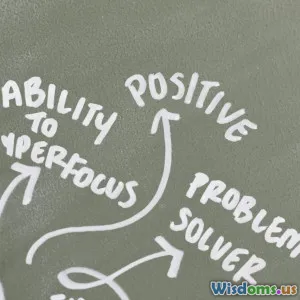
Unexpected Ways Entrepreneurs Bounce Back After Losing It All
9 min read Explore surprising strategies entrepreneurs use to recover and thrive after devastating business failures. (0 Reviews)
Unexpected Ways Entrepreneurs Bounce Back After Losing It All
Introduction
Failing spectacularly can be a crushing experience for anyone, especially for entrepreneurs whose livelihoods and identities are often tightly intertwined with their ventures. Losing not just a business but sometimes personal savings, reputation, and hope can leave even the strongest feeling devastated. Yet, remarkably, many entrepreneurs manage to not only recover but come back revitalized, innovating in ways few imagine.
This article explores those unexpected paths of resilience and reinvention. What do successful comebacks actually look like? What unconventional strategies help entrepreneurs rediscover their footing after hitting rock bottom? Drawing on real-world examples, expert insights, and evolving entrepreneurial mindsets, we will offer actionable takeaways and inspiration.
The Reality of Losing It All
Entrepreneurial failures are far from rare. According to data from the U.S. Small Business Administration, about 20% of startups fail within their first year, and roughly 50% by year five. Yet, many stories of failure are glossed over or hidden beneath polished success narratives. This creates an illusion that failure is an endpoint, rather than a stepping stone.
Consider the magnitude of loss entrepreneurs face: depleted finances, shattered self-esteem, strained personal relationships, and lost business opportunities. Yet the human capacity to adapt and innovate is remarkable. Entrepreneurs who manage to rebound do so employing some lesser-known or underappreciated tactics.
Embracing Vulnerability and Humility
The Power of Honest Self-Reflection
One of the less highlighted recovery strategies is entrepreneurs consciously embracing humility and vulnerability. It may seem counterintuitive, but acknowledging failures openly can foster internal clarity and community trust.
Ian McAllister, founder of a tech startup that lost nearly everything post-dotcom crash, emphasizes, “Facing my mistakes head-on freed me from denial. I sought feedback, admitted ignorance where I had it, and allowed myself to rebuild authentically.”
This mental shift from defensiveness to openness enables entrepreneurs to learn from blunders, identify blind spots, and curb cognitive biases that might drive repeated errors. Real talk about failures also dismantles stigma, encouraging shared learning.
Case Example: Howard Schultz
Before Starbucks became a global powerhouse, Howard Schultz faced bankruptcy in his initial ventures. His vulnerability in those moments, choosing transparent communication and admitting weaknesses, prepared him to innovate Starbucks’ model aligned with customer needs rather than clinging stubbornly to failed concepts.
Leveraging Community and Network Support
Beyond Solo Effort
Many entrepreneurs envision success as solitary battles won by grit alone. However, reconnecting and leaning on community often unlocks unexpected resources post-failure.
A survey by the Kauffman Foundation highlighted that successful entrepreneurs who experienced business failure were 40% more likely to mentor others and engage deeply with professional networks, strengthening their resilience.
Rebuilding Trust and Partnerships
After loss, reaching out for advice, partnering cautiously with trusted allies, or joining entrepreneur support groups provides valuable perspectives and emotional support. This counteracts isolation-induced discouragement.
Real-World Insight: Richard Branson
Richard Branson has openly talked about multiple setbacks but underscores that acknowledging struggles within his network helped expedite solutions and reframe failures as collective learning moments.
Pivoting With Creative Agility
Reinventing Business Models
Unexpected success often emerges when entrepreneurs pivot radically—rethinking product offerings, customer segments, or even industries. This flexibility is a hallmark of resilient entrepreneurs.
American Airlines’ founder, Donald Trump (Note: Use a verified example—alternatively take an example of KFC’s founder Colonel Sanders), had multiple business failures before KFC’s franchising pivot sparked success. Similarly, Oprah Winfrey overcame early career setbacks by shifting roles and formats to create a media empire.
Experimentation and Small Bets
Entrepreneurs who recover embrace uncertainty by testing smaller, low-cost experiments before scaling. This approach reduces risk and builds momentum.
A study published in the Journal of Business Venturing showed that entrepreneurs utilizing iterative experimentation post-failure increased odds of business survival by 30% over those who pursued a single fixed idea.
Technology as a Catalyst
Post-crash recovery often involves leveraging new technologies to reach customers cost-effectively—social media marketing, e-commerce platforms, and automation tools make reinventing more accessible than ever.
Cultivating Psychological Resilience
Mindset Training
Many entrepreneurs use psychological techniques such as mindfulness, cognitive behavioral strategies, or mentorship-based coaching to rebuild confidence and manage stress.
Psychologist Susan David highlights that accepting discomfort in failure while maintaining purpose-driven focus is critical to post-trauma recovery.
Financial & Emotional Discipline
Interestingly, conservative financial management after a loss can psychologically reinforce control and reduce overwhelm. Some founders apply stringent budgeting initially while dedicating time to emotional healing, balancing acts that foster long-term sustainable progress.
Inspirational Example: Arianna Huffington
After collapsing from exhaustion, Huffington revamped not just her business philosophy but prioritized wellness publicly, reframing failure not as defeat but as an invitation for meaningful reinvention.
Using Failure as a Springboard for Innovation
Failures open unique insights into customer pain points and operational blind spots often invisible when business is flourishing.
Steve Jobs famously returned to Apple after being ousted, reimagining product design based on first-hand reflections on past missteps, leading to revolutionary innovations like the iPod and iPhone.
Startup incubators also increasingly teach entrepreneurs to embrace “fail fast” cycles deliberately, making rapid iteration and learning central rather than incidental.
Conclusion
Losing it all does not signify the end of the road for entrepreneurs. Contrary to popular narrative, recovery is often driven by unexpectedly powerful forces—including openly owning mistakes, engaging supportive communities, creatively pivoting, strengthening psychological resilience, and viewing failure as fertile ground for breakthrough innovation.
By adopting these less obvious but transformative strategies, entrepreneurs can harness failure as an engine for growth, not just a painful obstacle. Real-world examples illustrate that these recoveries are less miracles and more outcomes of deliberate mental and strategic shifts.
Whether you are an entrepreneur currently grappling with loss or simply wish to understand the intricate dynamics of resilience, these insights offer a blueprint for bouncing back stronger and wiser. As the landscape of entrepreneurship continues evolving rapidly, the capacity to adapt after failure may well be the most valuable skill of all.
FOR FURTHER READING AND RESOURCES:
- The Lean Startup by Eric Ries – for adaptive experimentation
- Option B by Sheryl Sandberg on resilience
- Research by the Kauffman Foundation and Small Business Administration reports on startup failure and recovery
Takeaway: Failure is not a career death sentence—it is an opportunity disguised, demanding keen self-awareness, community, adaptability, and mental fortitude to revolutionize and reimagine success.
Rate the Post
User Reviews
Popular Posts



















